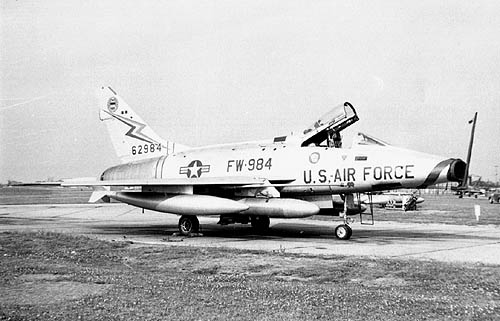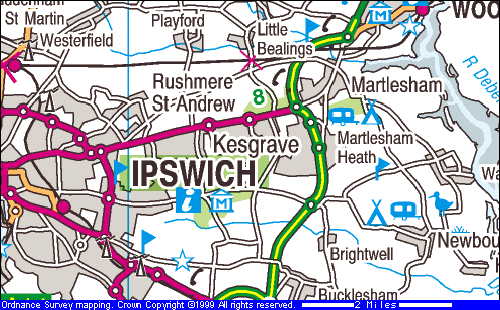|
Home | Airshows | The Hangar | Nostalgia | f4's F4s | Wattisham Chronicles | Links |
| Catastrophe
at Kesgrave by David Keeble
At 09:53 precisely, the two jets accelerated with a roar and climbed into the cold air over the peaceful Suffolk countryside. Leading this early morning training mission was 23-year-old Lt Guary Walker, whilst his wingman was Lt Charles Prescott, a 27-year-old family man who had been in England for over two years. Two minutes later, passing 1,700 feet in the climb at about 300 mph, Walker glanced over to his companion's aircraft, and saw flames coming from the rear of the machine. Quickly pulling away, he ordered his wingman to eject. By this time however, Prescott was struggling with his controls, and just as his leader's message registered on his mind, a red fire-warning lit up in front of him. He pulled the handle of his ejector seat. The seat performed as advertised, and the young pilot made a clean exit from the roomy cockpit of 56-2985, to find himself hanging from his parachute over the disused airfield at Martlesham Heath. As his leader swept into a wide orbit overhead, Prescott looked down as a helpless spectator on the tragic events about to unfold beneath him.
Fearing a heavy casualty list the Suffolk Fire Service sent out a general alarm from Ipswich, as civilian and military emergency vehicles converged on the scene. American and Suffolk firemen worked alongside each other to fight the flames that were leaping from the wreckage and rubble that covered the scene. Their task was hampered by repeated explosions, thought at the time to be due to live ammunition, but later said to be exploding Calor Gas containers. All through-traffic was diverted from the busy A12 road for some hours by East Suffolk police and the USAF police co-operated in keeping spectators (including your author) away from the scene of devastation. As the wind carried Prescott's parachute gently towards the nearby River Deben, the shaken pilot watched, grief stricken, as his aircraft wrought havoc on the ground below him. Finally he landed near Martlesham Church, about two miles from the scene of the crash, and was found, distressed, but otherwise unhurt except for a scratch on the face. Over forty years later, Kesgrave shows no signs of the disaster on that December day. Footnote: Robert Ward provides an eye-witness account of that fateful day. I was
living four houses from Falcon Caravans at the time of the crash.
I was seven years old at the time but I can still remember that terrible
day - my Grandfather was at the top of our garden when he saw the
jet coming. He couldn't run fast so he crouched under a large wheelbarrow
for protection, but was very badly burned. I can remember my family
trying to put out his burning clothes. We were moved two houses further
away from the fire (I don't know why the authorities thought that
was a safe distance, lots of panic I suppose). I can clearly remember
our garden covered in fire and the sound of live shells going off
- Dave mentions that the explosions were thought to be gas cylinders
and indeed some of them probably were but I can confirm that the aircraft
was armed with cannon shells, many of which myself and my cousins,
who lived next door, collected and placed on a straw bed in a wheelbarrow
for collection by the authorities. The bomb disposal team spent several
weeks combing the gardens in the area for cannon ammunition - every
morning an Army lorry would drop off the bomb disposal team and they
would systematically search the area with metal detectors. Sadly my Grandfather died from his burns several days later.
|
 It
was about 09:45 on Monday 29 December 1958 as two North American F-100D
Super Sabres of the 20th Tactical Fighter Wing of the United States
Air Force rolled smoothly down the taxiway at their base at RAF Woodbridge,
Suffolk. The weak winter sunshine glinted off their polished aluminium
and emphasised the bright yellow markings of the 79th Tactical Fighter
Squadron, as the aircraft turned onto the wide runway.
It
was about 09:45 on Monday 29 December 1958 as two North American F-100D
Super Sabres of the 20th Tactical Fighter Wing of the United States
Air Force rolled smoothly down the taxiway at their base at RAF Woodbridge,
Suffolk. The weak winter sunshine glinted off their polished aluminium
and emphasised the bright yellow markings of the 79th Tactical Fighter
Squadron, as the aircraft turned onto the wide runway. The
village of Kesgrave runs like a ribbon beside what was the old main
A12 road on the eastern outskirts of Ipswich, almost directly below
the flight path for RAF Woodbridge. Since the second world war the
residents had become conditioned to the sound of jet engines, as F-86
Sabres, F-84 Thunderjets and Thunderstreaks and then F-100 Super Sabres,
passed overhead. On that December morning, which for many was the
first working day since Christmas, local people were oblivious of
the drama occurring above them. The blazing Super Sabre struck a caravan
dealer's garage almost vertically, killing a woman employee. The fully
fuelled aircraft exploded on impact, completely demolishing the garage
premises and an adjoining bungalow. Twelve caravans on the forecourt
and two vehicles were destroyed, but luckily an underground tank,
holding 2,000 gallons of petrol, was undamaged. Blazing fuel and wreckage
were thrown onto a house and boarding kennels next door, burning off
the roof and gutting the top storey. Electricity and telephone wires
were brought down and minor damage caused to many surrounding properties.
The
village of Kesgrave runs like a ribbon beside what was the old main
A12 road on the eastern outskirts of Ipswich, almost directly below
the flight path for RAF Woodbridge. Since the second world war the
residents had become conditioned to the sound of jet engines, as F-86
Sabres, F-84 Thunderjets and Thunderstreaks and then F-100 Super Sabres,
passed overhead. On that December morning, which for many was the
first working day since Christmas, local people were oblivious of
the drama occurring above them. The blazing Super Sabre struck a caravan
dealer's garage almost vertically, killing a woman employee. The fully
fuelled aircraft exploded on impact, completely demolishing the garage
premises and an adjoining bungalow. Twelve caravans on the forecourt
and two vehicles were destroyed, but luckily an underground tank,
holding 2,000 gallons of petrol, was undamaged. Blazing fuel and wreckage
were thrown onto a house and boarding kennels next door, burning off
the roof and gutting the top storey. Electricity and telephone wires
were brought down and minor damage caused to many surrounding properties.